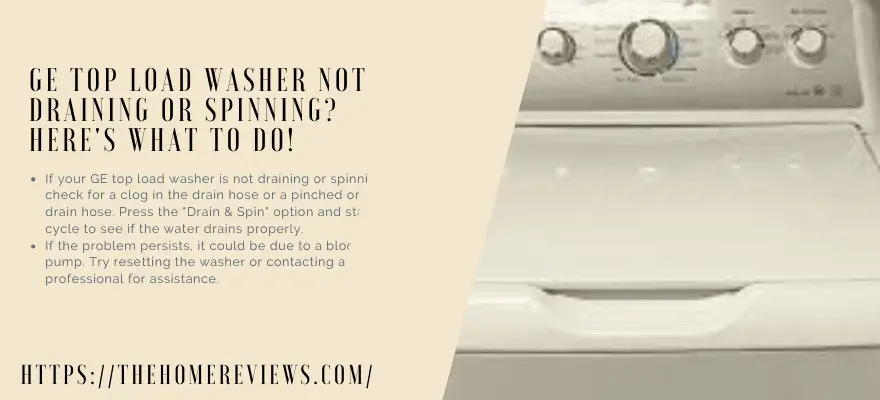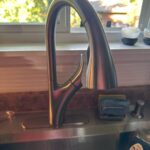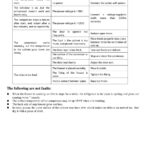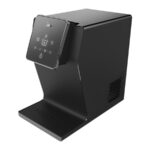If your GE top load washer is not draining or spinning, check for a clog in the drain hose or a pinched or flattened drain hose. Press the “Drain & Spin” option and start the cycle to see if the water drains properly.
If the problem persists, it could be due to a blocked drain pump. Try resetting the washer or contacting a professional for assistance.

Why Is Your Ge Washer Not Draining or Spinning?
Is your GE top-load washer not draining or spinning? It could be due to a clog or a pinched or flattened drain hose. Try selecting the Drain & Spin option or checking for any obstructions in the hose to resolve the issue.
Possible Reasons for a Ge Washer Not Draining or Spinning:
- Clogged drain hose: The drain hose may be blocked by debris or lint, preventing water from draining properly. To check, remove the drain hose and inspect for any clogs. Clear any blockages and reattach the hose securely.
- Faulty drain pump: The drain pump is responsible for removing water from the washer. If it is not working correctly, the water will not drain. Test the pump by listening for a humming noise during the drain cycle. If there is no sound, the pump may need to be replaced.
- Broken lid switch: The lid switch ensures that the washer will not spin if the lid is open. If the switch is faulty or broken, the washer will not drain or spin. Check the lid switch for any visible damage and replace it if necessary.
- Malfunctioning motor capacitor: The motor capacitor provides the necessary power to start the motor. If it is defective, the motor may not function properly, resulting in a washer that does not drain or spin. Test the capacitor using a multimeter and replace it if it fails the test.
- Worn-out motor drive belt: The motor drive belt transfers power from the motor to the drum. If it is worn out or broken, the drum will not spin. Inspect the belt for any signs of damage and replace it if necessary.
Importance of Addressing the Issue Promptly:
- Prevents water damage: If the washer is not draining properly, excessive water may remain in the drum. This can lead to water leaking onto the floor and causing damage to your home.
- Avoids foul odors: Standing water in the washer can result in a stagnant odor developing over time. Promptly addressing the draining issue ensures that the washer remains clean and odor-free.
- Extends the lifespan of the washer: Regularly draining the washer as intended reduces the strain on its components, preventing unnecessary wear and tear. By addressing the issue promptly, you can help prolong the lifespan of your GE washer.
- Saves time and money: A washer that doesn’t drain or spin properly can lead to extended wash cycles or incomplete cleaning. By addressing the issue promptly, you can avoid wasting time and energy on inefficient washing cycles. Additionally, resolving the problem early on can prevent more significant repairs down the line, saving you money in the long run.
Remember, addressing the reasons why your GE washer is not draining or spinning is crucial to maintaining the efficiency and lifespan of the appliance. By promptly resolving these issues, you can ensure a properly functioning washer and avoid costly repairs or potential water damage.
How To Diagnose The Problem
If your GE top-load washer is not draining or spinning, there might be a clog in the drainage system. You can try selecting the “Drain & Spin” option or check for any blockage in the drain hose.
When your GE top-load washer is not draining or spinning, it can be frustrating and inconvenient. However, diagnosing the issue doesn’t have to be difficult. By following these simple steps, you can identify the problem and take the necessary steps to fix it.
Checking for a Clogged Drain Pump or Drain Hose:
- Inspect the drain pump:
- Check for any clogs or obstructions in the drain pump.
- Look for debris, such as lint, or small objects that may be blocking the pump.
- If clogged, remove the obstruction and clean the pump thoroughly.
- Examine the drain hose:
- Ensure that the drain hose is not kinked or bent, as this can prevent proper drainage.
- Check for any clogs or obstructions in the drain hose.
- If clogged, clear the blockage by running water through the hose or using a pipe cleaner.
Inspecting the Lid Switch and Motor Capacitor:
- Check the lid switch:
- Make sure that the lid switch is functioning correctly.
- Open and close the lid to see if there is a clicking sound, indicating that the switch is working.
- If the switch is faulty, it may need to be replaced.
- Test the motor capacitor:
- Ensure that the motor capacitor is in good condition.
- Use a multimeter to check for continuity in the capacitor.
- If there is no continuity, the capacitor may need to be replaced.
By following these steps and checking for a clogged drain pump or drain hose, as well as inspecting the lid switch and motor capacitor, you can effectively diagnose the problem with your GE top load washer that is not draining or spinning.
Once you have identified the issue, you can proceed with the necessary repairs to get your washer working again.
Steps To Fix A Ge Washer That Won’t Drain Or Spin
If your GE top-load washer is not draining or spinning, there are a few steps you can take to fix the issue. First, check for any clogs or blockages in the drain hose. You can also try resetting the motor or replacing the pump, if necessary.
If your GE top-load washer is not draining or spinning, it can be frustrating and inconvenient. However, there are a few steps you can take to troubleshoot and fix the problem. Follow the steps below:
Removing the Ge Washer Console and Top:
- Unplug the washer from the power source to ensure safety.
- Locate the screws at the back of the console and remove them.
- Carefully lift the console, being mindful of any wires still attached.
- Disconnect the wire harnesses to fully detach the console.
- Next, locate and remove the screws holding down the top of the washer.
- Lift the top panel to access the inner components.
Locating and checking the pressure port:
- Look for the pressure port, usually located on the side or back of the washer.
- Remove the rubber tube connected to the pressure port.
- Blow into the tube and listen for a clicking sound to ensure it is clear of any blockages.
- Reconnect the rubber tube securely.
Testing and Replacing the Drain Pump If Necessary:
- Locate the drain pump, usually at the bottom of the washer.
- Disconnect the wires and hoses connected to the drain pump.
- Test the drain pump using a multimeter to check for continuity.
- If there is no continuity, replace the drain pump with a new one.
- Install the new drain pump by reconnecting the wires and hoses.
Remember, each washer model may have specific instructions, so refer to the user manual for detailed guidance. By following these steps, you can potentially fix your GE washer that won’t drain or spin. If the issue persists, it may be best to consult a professional technician or contact GE customer support for further assistance.
Additional Troubleshooting Tips
If your GE top load washer is not draining or spinning, try these troubleshooting tips. Firstly, check for a pinched or flattened drain hose. You can also try selecting the “Drain & Spin” option to see if the clog clears.
If the issue persists, there may be a problem with the drain pump or lid switch, and it may require professional repair.
Checking the motor drive belt for damage or wear:
- Inspect the motor drive belt for any signs of damage, such as fraying or cracks.
- Ensure that the belt is still properly attached and has not slipped off.
- If there are any issues with the belt, it may need to be replaced to restore proper spinning and draining functionality.
Properly Reinstalling the Washer Lid and Drain Hose
- Check that the washer lid is securely closed and properly aligned.
- Make sure that the lid lock switch assembly is functioning correctly.
- Inspect the drain hose for any kinks, obstructions, or damage.
- Ensure that the drain hose is properly connected to the washer and the drain pipe.
- If necessary, clean out any debris or buildup in the drain hose to facilitate proper draining.
Remember, regular maintenance and troubleshooting can help prevent issues with your GE top-load washer not draining or spinning. By checking the motor drive belt for damage or wear and properly reinstalling the washer lid and drain hose, you can often resolve these issues without the need for professional assistance.
Frequently Asked Questions
Why Is My Top Loading Ge Washing Machine Not Draining?
Your top-loading GE washing machine may not be draining due to a clog. To resolve this issue, press Start to resume the cycle, or select Drain & Spin and press Start. If the washer drains properly, the clog has likely cleared.
However, if water remains in the washer, check for a pinched or flattened drain hose.
Why Is My Washing Machine Not Emptying or Spinning?
One possible reason for your washing machine not emptying or spinning could be a blocked drain pump, obstructing the flow of water in and out of the machine. Check for any clogs or blockages in the outlet pipe and drain hose.
How Do You Reset a Ge Washer That Won’t Spin?
To reset a GE washer that won’t spin, start by checking for a clogged or flattened drain hose. If the hose is clear, press the Start button to resume the cycle, or select Drain & Spin and press Start. If the washer still won’t drain, you may need to replace the drain pump.
Where Is The Drain Pump On The Ge Top Load Washer?
The drain pump on a GE top-load washer is located underneath the washer, usually at the back or on the side.
Why Is My Top Loading Ge Washing Machine Not Draining?
There may be a clog. Press Start to resume the cycle, or you can select Drain & Spin and press Start. If the washer drains properly, then the clog has likely cleared. If water remains in the washer, check for a pinched or flattened drain hose.
Conclusion
If your GE top-load washer is not draining or spinning, there are a few common issues you can check for. One possibility is a clogged drain hose or drain pump, which can prevent water from properly flowing out of the machine.
To fix this, check for any kinks or obstructions in the drain hose and ensure it is securely connected. You can also inspect the drain pump for clogs or damage and clean or replace it if necessary. Additionally, a pinched or flattened drain hose can also cause drainage problems, so make sure it is properly positioned.
By addressing these issues, you can get your GE top-load washer back to draining and spinning efficiently. Remember to consult your washer’s manual or contact a professional if you are uncertain or need further assistance.




